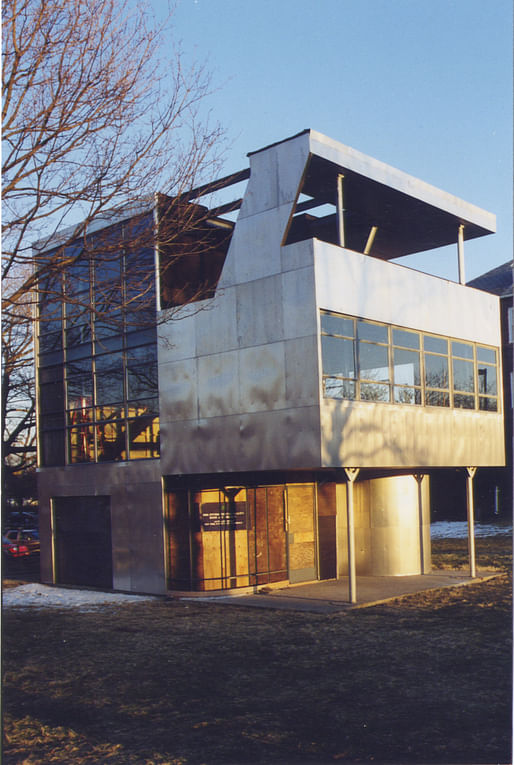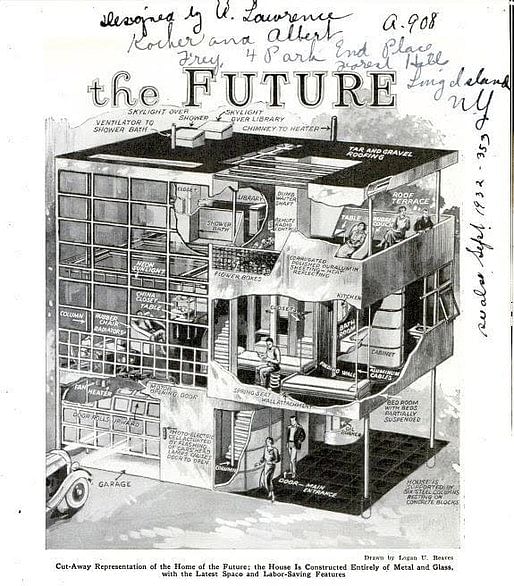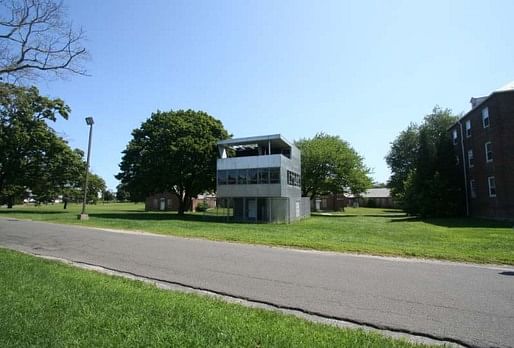

Lawrence Kocher and Albert Frey built the Aluminaire House in 1931 for an exhibition in New York City mostly out of mass-produced building materials donated by manufacturers. The project became recognized as an exemplary prototype of modern building forms and techniques at the time, while also introducing the idea of mass production and affordable home building in highly populated neighborhoods, a pressing issue that remains today. Over time, the Aluminaire House has been bought, relocated, redesigned, faced past threats of demolition, and even vandalized.
As explained in the press release below, the non-profit Aluminaire House Foundation, which was established to preserve the House, is currently aiming to relocate the structure to Sunnyside Gardens in Queens where it will be reconstructed to its original purpose for the first time since it was built.
The following article was submitted to us by Michel Schwarting...
Aluminaire house foundation, inc.
150-3 east main street port Jefferson ny 11777
The Aluminaire House, built in 1931 for an exhibition in New York City, moved to Huntington Long Island after the exhibition and to the Central Islip, Long Island campus of New York Institute of Technology in 1987 when threatened with demolition, has been dismantled and is in storage until it again gets rebuilt. The Aluminaire House Foundation has proposed to relocate the House in Sunnyside Gardens Queens and will have a hearing on the proposal at the Landmarks Preservation Commission in September.
Architects Lawrence Kocher and Albert Frey conceived and constructed the Aluminaire House for the Allied Arts and Industry and Architectural League Exhibition of 1931 at the Grand Central Palace (next to Grand Central Station but no longer existing) in New York City. It was intended to display standard mass-produced building materials, donated by the manufacturers. The most prominent material were the aluminum columns, beams and girders and the exterior panel cladding. Albert Frey conceived it as the “a”-“luminaire” house (concerned with light and air), addressing issues of new materials, affordable construction and housing.
The house was not only a display of products, but also a demonstration of their use in modern form making and in a repeatable affordable house, bringing together the ideas of mass production with high-density communities.
At the end of its’ week on exhibit, with over 100,000 visitors, the architect Wallace Harrison bought the house and relocated it on his property in Huntington, Long Island. In 1932 it was chosen by Hitchcock and Johnson as one of the few American examples for MoMA’s first architectural exhibition, and simultaneously published in their influential book, The International Style. Thus, it became known as the “Harrison Weekend House” rather than the repeatable prototype of experimental materials.
In 1987 the house was threatened with demolition. In a coordinated negotiation, the owner gave the building to New York Institute of Technology and NYIT accepted it, receiving grants for the dismantling, moving and reconstructing the house from New York State Department of Parks Recreation and Historic Preservation. The House was recorded and dismantled by architecture students and moved into storage at the NYIT Central Islip campus by 1989. Then began a slow process of reconstruction, again with classes of architecture students. When complete it was intended to be a museum open to the public and operated by the school faculty and students.
In 2004, NYIT closed most of the Central Islip, Long Island campus, relocating its programs to the Manhattan and Old Westbury campuses, including Architecture. The site is for sale and thus the house had to move again. NYIT turned the House over to the not-for profit Aluminaire House Foundation Inc. in 2011 to carry on with the intended project to save and restore the House and make it available to the public. The House was being vandalized since the early 2012, so it was decided to dismantle the house and put it in storage until an appropriate site can be found. This was accomplished on April 10, 2012. The Aluminaire House Foundation has been searching for an appropriate site in the low-rise, high-density residential edges of New York City. This would restore the house physically, and to its original intention of an easily constructed, low cost, modern urban house prototype that was being addressed in the early twentieth century and still remains critical today.
Once relocated and rebuilt, the Aluminaire House Foundation will achieve the goal of opening the house to the public to view the House and an archive of information on the project and the House.
Campani and Schwarting Architects have developed a design for the site at 39th Avenue and 50th Street in Sunnyside Queens. It locates the Aluminaire House on the corner and has an 8 unit residential building behind it to create an appropriate context for the house and its neighbors. We feel the site in Queens is appropriate to the time period and the ideology of the Aluminaire House. It is located at an intersection that faces the 1924-28 Sunnyside Gardens and the 1930 Phipps Houses by Clarence Stein and Henry Wright. These are important examples of the contemporary architectural response to the problem of housing for the periphery of the city. The house crossed paths with the Sunnyside Gardens housing with its inclusion in the 1932 MoMA exhibition: “Modern Architecture: an International Exhibition”, Hitchcock and Johnson curators.
 Wright and Stein curated the housing segment of that exhibition with Catherine Bauer. The site in Sunnyside will restore the house to its intended context for the first time. The house will be open to visitors several times a year, and by appointment, as a museum through the Aluminaire House Foundation.
Wright and Stein curated the housing segment of that exhibition with Catherine Bauer. The site in Sunnyside will restore the house to its intended context for the first time. The house will be open to visitors several times a year, and by appointment, as a museum through the Aluminaire House Foundation.
The Aluminaire House is 22’ 6” wide x 28’ 8” deep. It is supported by 6 aluminum columns and a mostly aluminum frame. The exterior 3” thick wall is clad with a slightly corrugated, overlapping aluminum panels on a 28” x 44” grid. The ground floor has a porch and entry hall and garage with drive in and out doors. The second floor has a double height living room, dining with roll out table, kitchen, bedroom and open bathroom. The third floor has a library/guest room, bath and terrace with “lawn”. The windows and doors are steel frame. The garage will be used to exhibit some of the original fabric of the house and could exhibit the Sunnyside Gardens and Phipps projects.
The residential building is intended to bring an essential income to the site and to serve asan appropriate backdrop for the Aluminaire House and connection to it adjacent context. The building faces the two streets of the corner site and creates a public mews space to view the Aluminaire House and provide a park space for the community. As with Sunnyside Gardens, which employed masonry as a enduring material, the residential building will be clad in terra cotta panels with a color and pattern of the scale of brick masonry of the neighboring context, while also referring to the Aluminaire panels with the panel joints. The small terraces refer to the open Aluminaire terrace. The ‘belvedere’ tower which serves to unify the building, is similar to corners in Sunnyside Gardens.
We believe that the Aluminaire House will make a positive contribution to the cultural milieu and historical significance of the Sunnyside Gardens Historic District.
2 Comments
By the headline and second paragraph, it sounded like the house would move into Sunnyside Gardens, but really the proposed location is across the street. The former made it seem interesting, since Sunnyside Gardens is a landmark district, and it would be tricky to insert this house into it. Nevertheless there is synergy in the ideas of both that would make sense beyond on any formal differences.
YES! I was in this building and I lived in he brick building in the background my first year of architecture school. Glad to see it is being saved, thanks Michael and Frances I can't wait to see this in Queens soon.
Block this user
Are you sure you want to block this user and hide all related comments throughout the site?
Archinect
This is your first comment on Archinect. Your comment will be visible once approved.